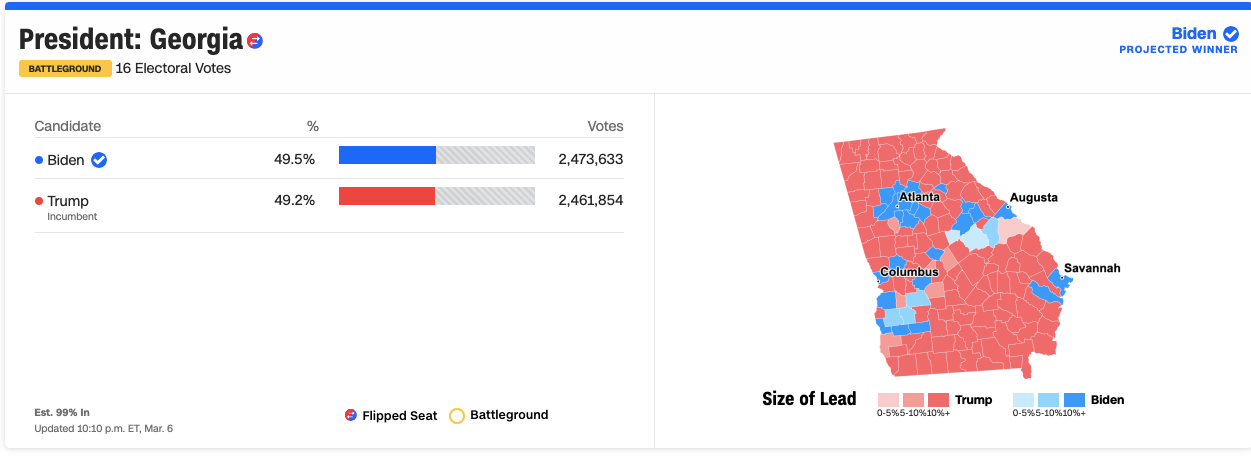Welcome to my newsletter, King Williams. I am a documentary filmmaker, journalist, podcast host, and author in Atlanta, Georgia. This newsletter covers Atlanta's hidden connections and everything else.
Georgia Nears 4 Million On Last Day Of Early Voting
Friday marked the end of early voting in Georgia, leaving this Tuesday, November 5th, as the only remaining day to vote in the 2024 Presidential Election. Both parties feel optimistic heading into Tuesday, as Republicans have shown day-to-day consistency and overperformance. At the same time, the Democrats have begun to close the gap in a late second—and third-week surge. This race is far from over, and both parties aren’t letting up in their efforts.
The Numbers: Early Voting
The total turnout is now 4,014,075 people, representing 55.4% of all eligible voters. 3.7 million people have voted in person, while ~250,000 have voted absentee. Compared to the 2020 election, 2024’s early voting totals are now running slightly ahead at roughly +2% of the same level of turnout—3.93 million people in 2020 versus 4.0 million in 2024.

Absentee Ballots
While absentee ballots were down in 2024 compared to 2020, this is in part due to changes to voting, including massive changes due to the Republican-led SB202 in 2021. This has resulted in limited access to absentee voting, which has seen voting move more in person instead.
Roughly ~92,000 absentee ballots have yet to be turned in, including an estimated ~3,000 people in Cobb who have had issues receiving their ballots and have had an emergency second set issued.
If an absentee ballot was requested and accepted, but the ballot has not yet been received, please contact both your county’s election office and the Secretary of State’s office.
You may have to go in-person to your local voting precinct to vote.
Absentee ballots can be dropped off tomorrow and Monday but you must check your county’s board of elections to figure out time and location.
All absentee ballots must be turned in to a precinct by the close of the voting period on Tuesday to be counted.
2. The Big Story Of Early Voting Is…
The story of early voting remains the same: smaller, more rural, and likely conservative/Republican-supporting districts overperformed during early voting, while larger, more urban, and likely Democrat-supporting districts are still slightly underperforming. But those Democrat-supporting districts have picked up over the last two weeks, starting with October 24th’s Obama-Harris-Springsteen rally in Clarkston.
Since that rally, turnout amongst Democratic strongholds DeKalb, Clayton, and Fulton counties—the counties that tipped Biden in 2020—and newer blueland territories in metro Atlanta, Cobb, Rockdale, Newton, Henry, and Gwinnett have all seen substantial pick-ups in the last days of early voting.
The second story of the early voting period is women showing up.
The second story about early voting is about women showing up…everywhere. Women have outnumbered men by double digits since the first day of early voting and have not stopped. Whether it is a liberal, centrist, or conservative county, the women have dominated the early voting period. Women currently account for about -56% of the total turnout, which could expand in turnout on Tuesday.
If the trends happening during the early voting period are any indication, women will be the decision-makers in the 2024 election in Georgia and nationally. For parties, this could be a much-needed delight or dread.
For the Democrats, this could be a much-needed counter-punch to the GOP’s early voting success. The question is whether these women are over-indexing to vote for Harris or if they are more motivated women to vote for Trump or a third-party candidate.
For Republicans, this could be a concern as women could be motivated by the party’s statewide 6-week abortion ban as well as national murmurings of the potential moves against abortion, IVF, and contraceptives. Republicans have about 48 hours to figure out a way to reach out to their base of female voters one last time before Tuesday, but the messaging has been nonexistent up until this point. It's also an opportunity to energize steadfast conservatives and men who have tilted toward the GOP over the last 4-8 years.
3. Did the Republicans peak during early voting?
The typically Republican-supporting counties showed up big during the early voting period. However, the GOP may have reached its ceiling as some counties will reach nearly 100% of registered voters by the end of Tuesday.

Many counties overperformed in rural Georgia have substantially smaller and/or declining populations, which could leave Republicans scrambling for additional turnout on Tuesday.
Of the five largest counties by overall voting percentage, Towns (7K), Oconee (21K), Dawson (16K), Forsyth (109K), and Rabun (8.5K), the actual total number of voters (~155K) is less than half of the entire early totals of DeKalb, Gwinnett, Fulton, or Cobb. When adjusting for a similar split in 2024 compared to 2020, those counties have fewer voters than Trump received in actual voters in Cobb (165K) in 2020. This is combined with another trend: rural Georgia’s population is declining.
Via the Saporta Report: Rural Georgia emptying; state power liable to shift north - 8/17/2021
There are about a million more Georgians now than there were 10 years ago. Or, according to key Census figures published Wednesday, a population of 10,711,908 now versus 9,687,653 folks in 2010.
But growth of more than 10 percent still wasn’t enough to justify a new member of the U.S. House of Representatives for Georgia. So there will still be 14 representatives, now representing a population that’s much more likely to live above Interstate 20 than just a decade ago.
And that’s the conundrum that will face the GOP-controlled state legislature this year as it redraws political boundaries: every Georgia House, Senate and congressional district has to have the same number of adults.
But it would take Georgia’s 85 least-populous counties just to add up to the whopping 1.07 million people now living in Fulton County alone.
Indeed, 67 of Georgia’s 159 counties lost population between 2010 and 2020. For some counties, like Candler, the drop is less than a percent, almost a rounding error: 10,998 in 2010 and 10,981 now.
When using the 2020 turnout as the proxy and adding the top 5 Republican-supporting counties in the state by actual residential population—Cherokee, Forsyth, Hall, Paulding, and Columbia had about the same total of active voters, ~525K, as Fulton County, ~523K. A county fwiw that went ~73% for the Dems in 2020, translating to 380K votes. And without (declining) but relevant support for the GOP within the five major counties, the GOP can’t win Georgia.

This sets up a numbers game that the GOP doesn’t want to play—
There are more likely Democrats or Democrat-supporting voters than Republicans remaining; whether they vote or vote for Harris is still TBD.
There are much larger Dem-supporting cities and counties that haven’t reached even plus-50% or greater, which could cause problems. Especially if that means DeKalb, Fulton, Cobb, Clayton, and Gwinnett all get over 70% or better or even 80% or better in overall turnout. Assuming the vote splits are similar to 2020. This could be a long night for the GOP, especially if DeKalb and Fulton get over that threshold.
Should the Democrats finally pick up over 70% or better in their traditional supporting cities/counties outside the metro, such as Savannah, Columbus, Augusta, Athens, and Macon, this could be all the difference in Georgia going blue again, assuming a similar 2020 D/R split.
This means the GOP in Georgia will need to get a turnout of upwards of 80% or better in the counties already voting in record numbers. They will need these counties to comfort them in their presumed lead or hedge against likely growth in metro Atlanta and the non-metro cities. This assumes the Dems will pull numbers closer to 80% or better in total turnout in metro Atlanta and around 75% or better in Augusta, Athens, Macon, Columbus, Savannah, and the Black Belt on Tuesday.
The Republicans hope Tuesday is lighter than usual for the Democrats. In addition to a hopeful push of enough upset, Democrats (especially black voters) decide to split the ticket or not vote for Harris. There is an indication that the larger youth vote, especially among young men 18-29, could be beneficial, especially in metro Atlanta. This demographic could be a stealthy vote as more young men are becoming more conservative and more likely to engage with conservative media, creators, personalities, and political content.
4. A New Turnout Record Could Be Set
There are some indications that Tuesday’s turnout could break the state’s all-time turnout record. In 2020, ~5 million people voted. There’s a good possibility that the number will be as high or better. Both parties believe they can exceed their 2020 totals and may be right.

Turnout in 2020 saw roughly ~67.0% of all registered voters (5m out of 7.4m) vote. This led to Georgia ranking 10th nationally in total ballots cast in 2020, 10th in eligible voters, and 27th (including DC) in overall percentage. Both Trump and Biden finished with just under 2.5 million votes each, translating to nearly 1 in 3 of all registered voters casting a ballot for either a Democrat or a Republican. The real question is whether one or both candidates reach 3 million, again settling the all-time record.
First-time voters will factor into this election, as over 500,000 people who voted this year didn’t vote in 2020. However, the turnout for both parties will likely need to exceed 500,000+ voters each on election day. This assumes the split is again similar to the 2020 split of 50/50 for president, with around ~2 million early votes going to Trump and Harris. Based on the 2024 turnout so far, the current split is projected to be more favorable for Trump, putting more pressure on Harris to deliver big on Tuesday.
If Republicans' early voter turnout is a concern for Democrats, potentially somewhere between 500,000 and 1 million voters could be needed. This could be a required once-in-a-generation performance for bigger counties like DeKalb, Gwinnett, and Fulton, which are all running between 75-100,000 below their 2020 turnouts.
This could be another Kemp vs. Abrams II scenario. Republicans are doing well in the small towns and rural parts of the state, providing a comfortable counter to the Democrats, who need metro Atlanta + the black belt to win.
5. The Bigger Picture
For Republicans
This is cautious optimism—this is Dua Lipa’s radical optimism energy. Optimism despite the danger and warning signs.

Suppose this was any other candidate in any other election, and at any other time, it would be over. Despite the polls going in all types of directions, the summer Kamala surge, and Trump’s recent in-person performances, the GOP can once again count Georgia as Trump Country.
The GOP should be feeling good about their chances. Early data shows the party’s core of older, male, and rural county base voters are showing up in record numbers, giving them renewed optimism with the added benefit of SB202 tipping the scales in favor of Republican-supporting counties.
But if this election plays similarly to the 2022 midterms and the Georgia Gubernatorial race, in which the most ardent voters went during the early voting, Tuesday could be a slow day for both parties. In that election, the Republican candidate, incumbent Governor Brian Kemp, saw a roughly 20% surge in overall turnout at 2.1 million voters. In contrast, the Democratic challenger, Stacy Abrams, saw about the same turnout as in 2018 at ~1.8 million voters. Republicans can feel good about their future in 2026, too.
For Democrats
The Democrats, despite the enthusiasm of their core base, could be in trouble. It’s another case of the Everything is Fine GIF or another case of The Simpsons DNC-inspired meme of ‘We Hate Ourselves’—or not. Crisis averted.
Currently, every major Democrat-supporting county is still voting below its 2020 levels. This is partly due to 2021’s SB202, four years of culture wars, and a continuing post-Obama era decline in overall party enthusiasm. If this ends as it did in 2016, expect the Simpsons meme of DNC ‘We Hate Ourselves’ to once again be the topic of conversation locally and nationally.
Conclusion
For both parties, Georgia will be a potential backup state to look for nationally if things get interesting. Early polling and early voting totals show a tight race between both national candidates across several battleground states, including Georgia, without much room for error.
It all comes down to Tuesday, and every vote counts. Make sure you vote!
-KJW







